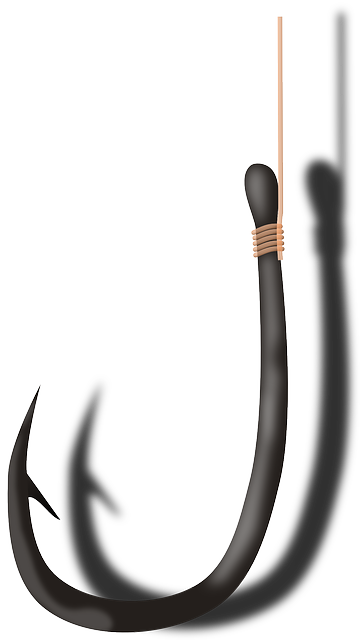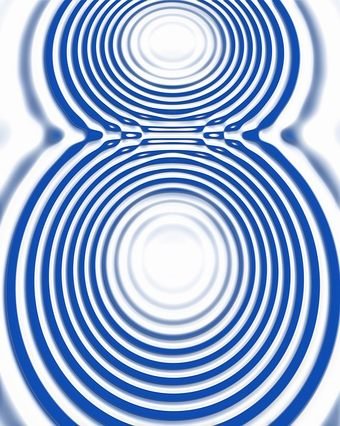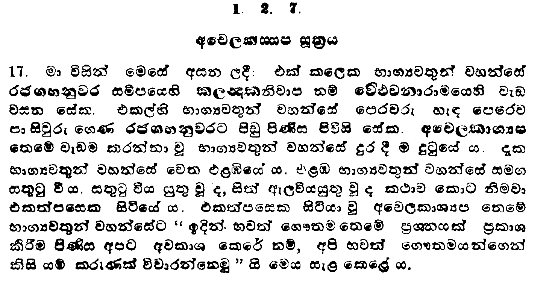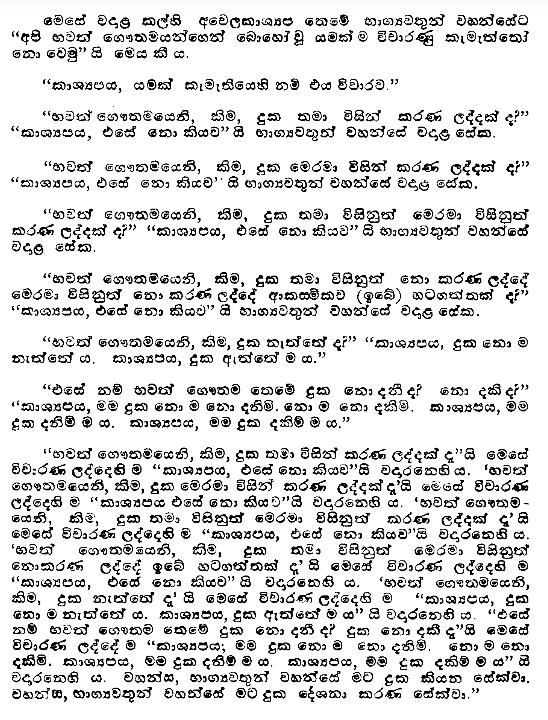Based on Ruwan Ranasinghe
Dhamma Talks
Three Questions
- Why we should attain Nibbana or try to be happy?
- What is happiness or Nibbana?
- How to do that?
Simple, yet powerful analysis of Happiness that we all seek, restlessly – every day.
නිවන් දැකිය යුත්තේ ඇයි?
This sansaric journey is not only goes through happy times, it faces many unwanted difficult times as well. Simply because, there is no guarantee, no-insurance for that.
මනුස්සචුති සූත්රය සහ දේවචුති සූත්රය අනුව චුත වන දේව මනුස්ස බොහෝ දෙනා උපදින්නේ දුගතියේ.
How come there is suffering?
Non of us wants that. Yet we all know it is there. So how come?
දුක කෙසේ කවුරු කල දෙයක් ද?
කෙනෙක් නිසා හටගන්නවා, භාහිර ලෝකය නිසා, මම නිසා දුක හටගන්නවා කියා ගැනීම දෘශ්ඨිගත වීමකි. දුක ඇත කියා ගැනීම සස්වත දෘශ්ඨියටත්, දුක නැත කියා ගැනීම උච්චේද දෘශ්ඨියටත් වැටේ.
What is ahead?
As a life form we have to figure out various challenges in our lives. When you think closely we have spent so much time in finding an answer to one important question. That is “How to be Happy?”
What is being happy? Long time ago, about 2500 years from today, the answer was discovered. The philosophy of this answer is known as Buddhism today.
Nibbana is another word for happiness. Lets start from there and explore deeper.
Three Universal Questions
- Why Nibbana?
- What is Nibbana?
- How to Nibbana?
සාධාරණ ප්රශ්ණ තුන.
- නිවන් දැකිය යුත්තේ ඇයි?
- නිවන යනු කුමක්ද?
- නිවන් දකින්නේ කොහොමද?
Why Nibbana?
Many who die gets a rebirth in lower realms where they have to spent millions of years in much un-happiness than happiness, that they used to enjoy while being a human. However, many does not know this and does not believe it thinking very optimistically about a bright and promising future in havens or some other existence. Comparing the amount of soil on earth Buddha compared that with amount with soil on his finger tip saying its only as much people get a better or equally good rebirth. Why this happens?
There are six (6) reasons for this.
0:17:00 මනුස්සචුති සූත්රය සහ දේවචුති සූත්රය අනුව චුත වන දේව / මනුස්ස බොහෝ දෙනා උපදින්නේ දුගතියේ. දුගතියේ උපන් කෙනෙක් නැවත සුගතියක ඉපදීමට ඇති ඉඩත් අවමයි. දුගතිය දුකින් පිරී ඇති තැනක්, සුගතියකට සාපේක්ෂව. ඉතින් දුකක් නැතිව ඉන්න තැනක් මේ තුල් ලෝකෙම, ජීවයක් පවතින තිස් එක් තලයේම නෑ. ඉතින් ඇයි දුකට වැටෙන්නේ?
එහෙම වෙන්න ප්රධාන හේතු 6ක් බලපානවා. නිවන නොලබන්න හේතු වන්නේ මේ හයයි. එහෙම වෙන්න කොහොමද කියල විස්තර සහිතව සොයා බලමු.
අලෝභ/nonGreed
ලෝභ/Greed
අද්වේශ/Anger
ද්වේශ/Anger
අමෝහ
මෝහ/Delusion
- නිවන් දකින්න ඕන ඇයි?
- 0:17:00 මනුස්සචුති සූත්රය සහ දේවචුති සූත්රය අනුව චුත වන දේව මනුස්ස බොහෝ දෙනා උපදින්නේ දුගතියේ.
- හේතු 6යි. ලෝභ, ද්වේශ, මෝහ, අලෝභ, අද්වේශ, අමෝහ. සුගති දුගති උපත් ලබන්නේ… මේ හේතු 6යේ යෙදීම අනුවයි.
- අහෝසිකම්මයකින් (එනම් ආනන්තරිය කර්මයකින්) වෙනස් නොවූයේ නම් මේ ආයුෂයය ගෙවී ගොස් චුත වෙයි, නැති නම් ආයු ගෙවී යන තුරු ඉපිද-මැරී සසර ගමන යයි.
- මේ දුකට වැටි වැටී යන්නේ -සිවු අරිසස් නොදුටු බැවින් බව තථාගත පර්යේෂණයක ප්රතිඵලයක්.
- නිවන් දැකිය යුත්තේ මේ දුකට නොවැටී සිටීම සදහාය.
What is Nibbana?
Time Tags are referred from video: https://youtu.be/D8zNRCKvDS4
- නිවන යනු කුමක්ද?
- දුකෙන් මිදීම නිවනයි.
- දුක කියන්නේ කුමක්ද? අනිච්ඡ ස්වභාය යි දුක.
- 0:41:00 උදාහරණය – පුසා සහ පැටවුන්…
- දුක ගැන අපි දන්නේ නැද්ද? දන්නවා. වේදනාවක් දැනුනම දුකයි. නමුත් ඒ දුක නැති කරගන්න කරපු දේවල්වත් තවම ඉවර වෙලා නෑ. ඉතින් අපි හරියට දුක දන්නව ද? නැත. බුදුවරු පවසන්නේ මේ දුක ගැන.
- 0:49:15 ලොවුතුරා බුදුවරුන් පවසන දුක, කලින් නොදන්නා.. නොදුටු දුකක් වන්නේ කෙසේ ද?
- බුදුසසුණේ දුක දැනගන්නේ ප්රඥා චෛතසිකයෙන්. අනෙක් සාසනවල දුක දැනගන්නේ වේදනා චෛතසිකයෙන්.
- 0:55:00 උදාහරණය – දියවැඩියාව සහ පැණි රස.
- දුකට පත් වන වැඩ පිළිවෙලට අපි ප්රියයි. නමුත් ඵලයට, එනම් දියවැඩියාවට කැමති නෑ.

- What is Nibbana?
- Relieving from Suffering is Nibbana.
- What is Suffering? Insatiability is suffering. Not being able to keep things/ideas the way want is suffering.
- 0:41:00 Example – the Cat and the kitten.
- Do we know suffering? We do. When we get hurt, we suffer. We try all our might to not to suffer that way, keep away from all aspects of suffering – is it successful yet? No. Can we take a break from attempting? No. So have we identified the suffering right?
- 0:49:15 No. This is the kind of suffering mentioned by Buddha. So, what is the difference?
- In Buddhism, suffering is not identified as associated with pain/hurt comes from sensory organs. Example: Tough/feel. Its more about an uninformed attempt due to delusion.
- 0:55:00 Example : Diabetes and Sugar.
- We love sugar, but not diabetes. Same way, we like the process of creating suffering, but wish no suffering to happen. Can this be done by a wish?
Really, You believe that?
That is where most us got it all wrong. Just by blindly beleiving it. Since some one we believed said so.
Then what? Find out yourself, if this is believable or not.
Time Tags are referred from video: https://youtu.be/D8zNRCKvDS4
මේ කියන්නේ ඇත්තද?
1:00:00 පිරිසිද බැලීම
උදාහරණය – බිලී වැද්දා සහ කලමනා… මාලුවාට සැප ගෙනදෙන දේද? දුක් ගෙන දේද?
විපාක දුක් ගැන හැම කෙනෙක්ම දන්නවා. දන්නේ නැත්තේ විපාකයක් බව නොදැන ඒ මත සාදා ගන්නා දුක යි. සංකිත්තේන පංච-උපාදාන්ස්කන්ධා දුක්කා කිව්වේ මේ ගැනයි.

Is this all True?
1:00:00 Lets look deep in to this.
Example: A fish monger and his equipment… What does that exactly bring to a fish? suffering or satisfaction?
Even, the fish knows about the suffering – like all of us do. We all know that we are going through happy as well as sad moments, as a result of good or bad things we do or did. I mean, most of us know that; at least. What most of us don’t know is about the suffering we created additionally on top of that. Fish likes to eat what is attached to the hook, but not the hook. When you crave for bait, suffering from the hook is already attached. Its a part of the deal. Like or not.
Who is responsible for this?
Of course it should be me? Well that’s what I thought. Many thousand years ago a wise man name Achela-Kassapa researched on this. At the end he asked the question from Buddha – who was well known to solve all the unsolvable questions. Achela wanted to challenge Buddha with the question.
At the end he got a very surprising answer. Lets see what that is.
Time Tags are referred from video: https://youtu.be/D8zNRCKvDS4
දුක කෙසේ කවුරු කල දෙයක් ද?
- 1:11:00 අචේල කස්සප සූත්රය – කවුරු කල දුකක් ද?
- දුක තමා කරගත්ත දෙයක් ද? එසේ නොකියව.
- දුක වෙනත් කෙනෙක් නිසා හටගත්තාද? එසේ නොකියව.
- දුක තමාත් වෙනත් කෙනෙක් නිසා හටගත්තාද? එසේ නොකියව.
- දුක ඉබේ හටගත්තාද? එසේ නොකියව.
- දුක කියා දෙයක් නැතිදිද? තිබේ. දුක ඇත්තේමය.
- තථාගතයන් දුක නොදනීද? දුක දන්නේය.. දුක දක්නේය.
කෙනෙක් නිසා හටගන්නවා, භාහිර ලෝකය නිසා, මම නිසා දුක හටගන්නවා කියා ගැනීම දෘශ්ඨිගත වීමකි. දුක ඇත කියා ගැනීම සාස්වත දෘශ්ඨියටත්, දුක නැත කියා ගැනීම උච්චේද දෘශ්ඨියටත් වැටේ.

Who created Suffering? How Suffering created?
- 1:11:00 Achila Kassapa Sutta – Achela asked about suffering.
- Is Suffering caused by me? Buddha said – Do not say so.
- Is Suffering caused by someone else? Do not say so.
- Is Suffering casued by me and someone else together? Do not say so.
- Is Suffering caused without a reason? Do not say so.
- Isn’t there something called Suffering? Sure, there is.
- May be you don’t know what is it then? Buddha said – Well, I know suffering. I see suffering.
Then Achela pleaded to explain the suffering as Buddha knows.

Who created Suffering? How Suffering created?
The full story is in Achela-Kassapa Sutta in Thripitaka. Buddha’s answer was “If you consider suffering as something caused by someone or something like you say so, you are going to get trapped in an extreme called mis-belief of existence. If you consider suffering is not existing, you are going to get trapped in an extreme called mis-bilief of non-existence.”
When the suitable dependencies arise, suffering occur. When the suitable dependencies does not arise, suffering does not occur. Buddha said this is a process called dependent origination (Paticcasamuppada / Patichchasamuppadha).
According to this, we can read out as there no relationship between suffering and existence or non-existence of me or some others. External or internal objects/non objects does not have a relationship to suffering.
So what really did caused suffering? Suffering is caused by delusion. The delusive nature as similar to what covered the hook in the bait to the fish who saw the bait as a juicy treat and wanted to manipulate/taste/enjoy it.
When the delusion is eradicated, suffering is non existant.
Two Ends and Middle
From the web page of https://www.dhammatalks.org/suttas/SN/SN12_17.html
“Kassapa, the statement, ‘With the one who acts being the same as the one who experiences, existing from the beginning, pain is self-made’: This circles around eternalism. And the statement, ‘With the one who acts being one thing, and the one who experiences being another, existing as the one struck by the feeling’: This circles around annihilationism. Avoiding these two extremes, the Tathāgata teaches the Dhamma via the middle.
Arising of Suffering
Tathāgata teaches how the suffering arise. This is the dependent origination cycle.
- From ignorance as a requisite condition come fabrications.
- From fabrications as a requisite condition comes consciousness.
- From consciousness as a requisite condition comes name-&-form.
- From name-&-form as a requisite condition come the six sense media.
- From the six sense media as a requisite condition comes contact.
- From contact as a requisite condition comes feeling.
- From feeling as a requisite condition comes craving.
- From craving as a requisite condition comes clinging/sustenance.
- From clinging/sustenance as a requisite condition comes becoming.
- From becoming as a requisite condition comes birth.
- From birth as a requisite condition, then aging-&-death, sorrow, lamentation, pain, distress, & despair come into play. Such is the origination of this entire mass of stress & suffering.
Cessation of Suffering
“Now from the remainderless fading & cessation of that very ignorance comes the cessation of fabrications. From the cessation of fabrications comes the cessation of consciousness. From the cessation of consciousness comes the cessation of name-&-form. From the cessation of name-&-form comes the cessation of the six sense media. From the cessation of the six sense media comes the cessation of contact. From the cessation of contact comes the cessation of feeling. From the cessation of feeling comes the cessation of craving. From the cessation of craving comes the cessation of clinging/sustenance. From the cessation of clinging/sustenance comes the cessation of becoming. From the cessation of becoming comes the cessation of birth. From the cessation of birth, then aging-&-death, sorrow, lamentation, pain, distress, & despair all cease. Such is the cessation of this entire mass of stress & suffering.”
අචේල කස්සප සූත්රය – බුද්ධ ජයන්ති ත්රිපිටකය
අචේල කස්සප
අචේල කස්සප යනු නිරුවත් තපස් රකින බ්රහ්මන කුලයක් බව තවත් පොත පතේ සඳහන් වෙනවා. මේ එවැනි බ්රාහ්මණයෙක් බුදුන් වෙත එළඹෙන අවස්ථාවක්.
Learn:
- දුක හටගන්නේ පටිච්ඡසමුප්පන්නව. පටිච්ඡසමුප්පන්නව දුක නිරෝධ වෙනවා.
දුකට මම සම්බන්ධ නැති බව අචේල කස්සප සූත්රයෙන් පැහැදිලි වේ. - එනිසා මම ඇත හෝ මම නැත යන්න දුකේ ඇතිවීමට හෝ නැති වීමට අදාල නොවන බව ඉතාම පැහැදිලි යි.
- දුක හටගන්නේ අවිද්යාව හේතුවෙන්. එනිසා අවිද්යා ප්රහානයටයි වෙහෙසිය යුත්තේ.
දුකට මුල් වු විවිධ ප්රශ්ණ රැසකට අප මුහුණදී සිටී. ලෝකයේ ප්රශ්න සියල්ල විවිධ ලෙස බෙදිය හැකිය. ඒ සියල්ල රූප, වේදනා, සංඥා, සංකාර, විඥාන ලෙස… රූප, ශබ්ධ, ගන්ධ, රස, ස්පර්ශ, ධම්ම… ආදී විවිධ ලෙස ගොඩවල් කර බෙදිය හැකිය. නමුත් මේ ප්රශ්ණ විසදා ගැනීමට වඩා ප්රශණයට හේතුව සොයා එයට පිරියම් යෙදීමෙන් මේ ප්රශ්ණ නැවත ඇති නොවීමෙන්ම ප්රශ්ණය විසදා ගනී.
ප්රශ්ණයට හේතුව කුමක්ද? අවිද්යාව යි.
Why Nibbana?
This is the only thing that we all deserve to have. That is Nibbana.
පිරිත්
පදයෙන් එහාට… කරණීය ධර්මයක් ලෙස
කර්ම චක්රය
Circle of Suffering…



